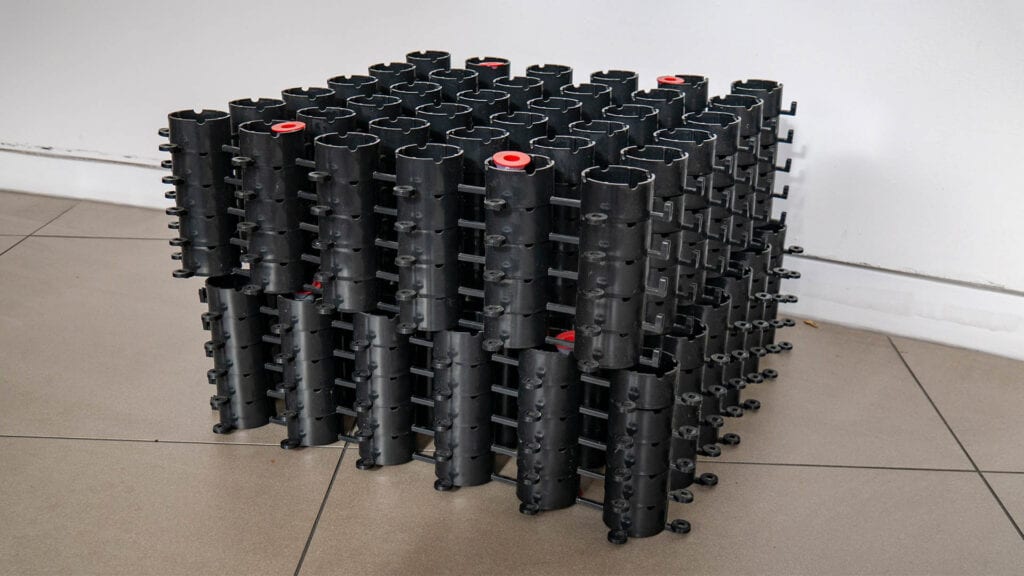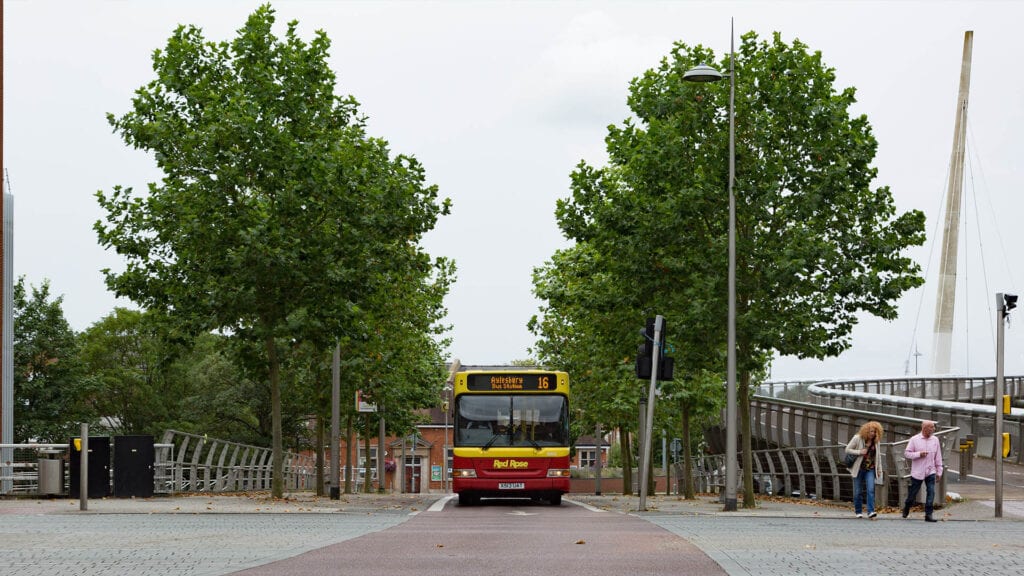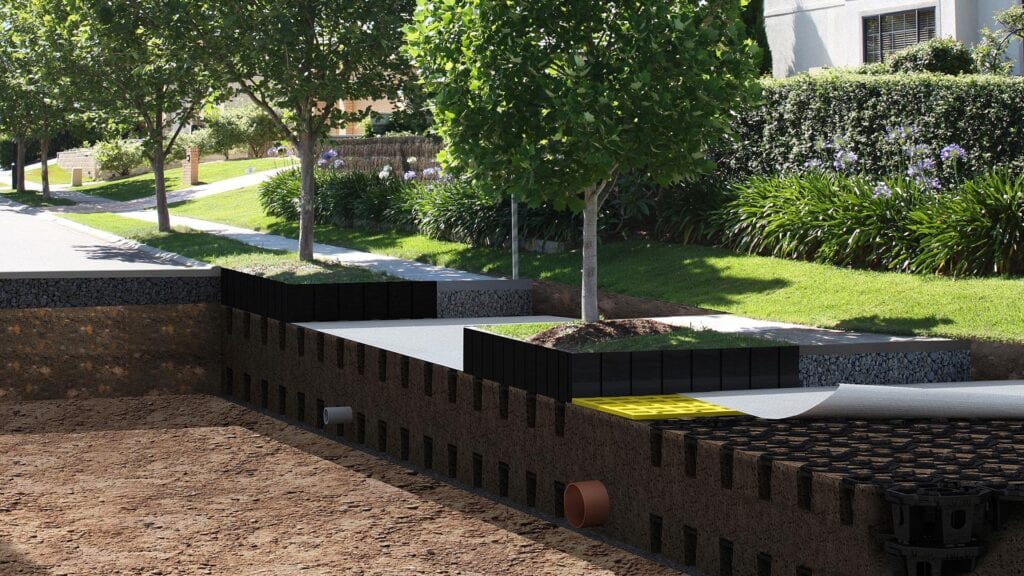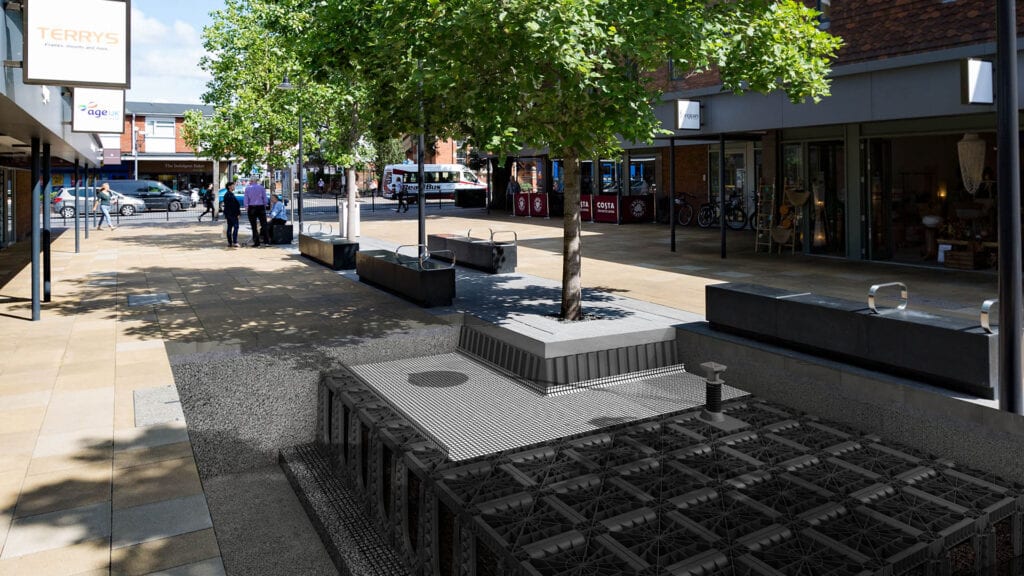Great cities are usually blessed with great trees; London, Paris, New York, Madrid, Buenos Aires, Tokyo and many, many others. These great trees are invariably older trees – maybe 100 years, 150 years, maybe even 200 years old; establishing their rooting patterns in urban soils – before the wall to wall impermeable paving we now view as normal. This restriction of water to rooting volumes allied with the high levels of sub-base compaction that are necessary to meet civil engineering requirements mean that tree establishment over the past 70 years or so has been unreliable.

It was this inability to guarantee long term tree survival that prompted the GreenBlue Urban CEO, Dean Bowie to think hard about how the natural forest floor environment could be recreated. Whilst in Denmark working with distributor Milford, the idea came to Dean – find a way to support the hard surface above to keep the high quality soil in optimum condition.

Now a days the idea of a soil cell is mainstream, but back in 2000 it was revolutionary. The first prototypes were constructed from grass support tiles, allowing fine tree roots to access the uncompacted soil within the cellular structure. Proving quickly that this methodology gave trees the best chance of early independence within the landscape meant that a new more cost effective cell to be designed. The RootCell was born; the first soil cell in the world to be designed solely for the establishment of tree roots.

Enlightened landscape architects, arboriculturists and local authorities quickly realised that it was common sense; using good uncompacted soil to get trees to grow isn’t exactly rocket science! However, the concerns of civil and highway engineers were more wary, concerned about the long term structural consequences of placing a plastic cell beneath load bearing surfacing. Testing has been carried out regularly, both third party test houses and internal testing, giving peace of mind and certainty for designers and installers. GreenBlue Urban has never had a soil cell collapse, and never had a tree fall over – a 20 year record of pride.
Working with distributors and specifiers it became clear that although the methodology was popular, the small physical size of the RootCell (250mm x 250mm x 90mm) and the need of a finely sifted soil to properly fill all the voids in the cells meant that a larger soil cell was needed. The StrataCell was launched in 2007, with more than ten times the volume of the RootCell, and was quicker to install, easier to fill, cheaper to ship and more cost effective to buy. With all of the advantages of the RootCells such as still being manufactured from 100% recycled material, fully interlocking with adjacent cells, both vertically and horizontally and very high loading capacity, the StrataCell soon became the most specified and installed soil cell in the world.

Tens of thousands of trees continue to thrive in StrataCells; every day these trees provide oxygen, attenuate stormwater, sequester carbon, provide habitat for a wide range of life forms and myriad other benefits for both nature and humanity. However, below our urban streets a labyrinth of services means that finding space for adequate tree rooting volumes challenging. The StrataCell can accommodate ducts and pipes up to 100mm diameter, but we found many larger or more complex services causing us to innovate with the next iteration of the soil cell.
Following consultation with specifiers and installers, GreenBlue Urban started design on an entirely new soil cell system. With a clear message from the consultation process that customers want a soil cell system that was simple to fill with soil, that could accommodate larger utilities and was cheaper to install, an internal design process began, with all employees invited to bring their ideas however wild to the table. Every proposal was carefully considered and Recalling a childs toy of interlocking tiles (Crystal Climbers) the final design of an interlocking 600mm high panel system incorporating an air deck was settled on and named RootSpace.

With the huge soil volume percentage (over 97%) by volume, RootSpace soil cells maximise available rooting volume, and minimise excavation required. With optional side panel inserts, very high lateral loadings can be coped with, meaning that they can be installed in nearly every environment. It is possible to stack RootSpace two or more cells high, giving numerous combinations of different cell formations.
Generation 2 RootSpace hit the streets in 2018 – improving on the already best soil cell on the international market! Launching the RootSpace 400, which can be used with the 600mm panel giving even more options for accommodating below ground constraints. Having passed a number of gruelling tests, the enviable certification from BBA was granted – RootSpace G2 is the only soil cell in the world to be awarded this.
GreenBlue Urban has lead in the landscape world with new innovative developments and collaborative workings. Celebrating our 30 year anniversary this July will encompass our peers across the industry to collate in both London and Manchester, sharing our recollections spanning over three decades. Together we can replicate and improve successful implementations when mainstreaming green and blue infrastructure in the built environment.
GreenBlue continue to dedicate research on trialing different designs and products to keep ahead – thinking differently, living better, creating healthier spaces in harmony with nature.



